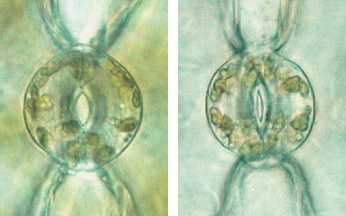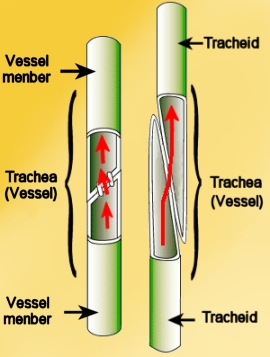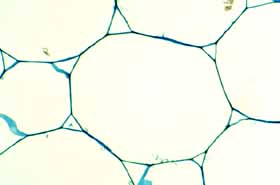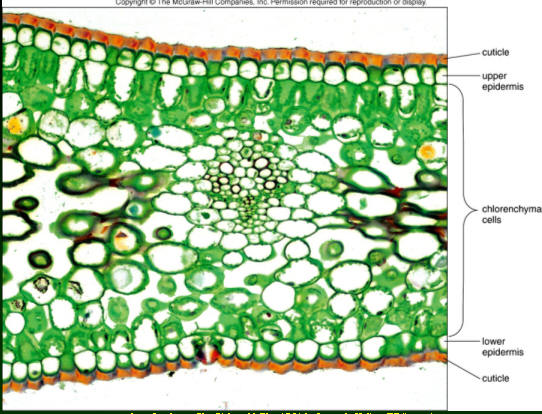Plant development:
- the zygote (2n) is a single cell that is formed by the fusion of a sperm and an egg
- it divides (by mitosis) into many unspecialized cells
- the unspecialized cells go through a process of differentiation to become the various tissues
1. Meristematic tissue (osztodó szövet)
- they are dividing cells for growth and will differentiate into the different tissues
3 types (based on position):
a. apical (csúcsmerisztéma) is at the tips of stems and roots, allows for growth in length
b. intercalary (köztes) is found at special points in leaves, stems and flowers, allowing for growth in length. They are especially important for the final shape and size of the plant
c. lateral is for lateral growth (also called secondary growth). There are 2 types: vascular cambium (edénykambium) which produces vascular tissue, and cork cambium (kéregkambium) which produces cork.
 |
| Meristems |
| Microscopic view of apical meristem of a pine tree |
 |
 |
 |
2. Permanent tissues (állandósult szövetek)
a) Epidermal tissues (börszövetek)
- tightly packed, brick-shaped cells with no spaces between them
 |
- above ground they are often covered by a cuticle and sometimes by a waxy layer, to protect against water loss, pathogen infection and mechanical damage. Additional structures might include hairs (these can protect against cold, trap moisture or release poisons), stomata (for gas exchange and transpiration)
 |
| Leaf hairs |
| Root hairs |
Stomata (sing. stoma) are special openings for gas exchange that are usually found on the undersides of the leaves. Openings are bordered by guard cells which are specialized epidermal cells. They are the only epidermal cells with chloroplasts and they have a thickened cell wall on the side of the cell that is facing the opening. They change shape to open or close the stoma. By increasing their water content, the cells swell, but due to thickened wall, instead of swelling all around, they form a bean shape, thus opening the stoma.
 |
| Microscopic view of stoma (open and closed) |
 |
b) Vascular tissues (szállítószövetek)
- two kinds: xylem and phloem
 |
Xylem (farész)
- carries water and minerals (usually upwards)
- cells are dead, long and hollow with lignified cell walls (for support)
- secondary xylem forms wood
- tracheids are found in ferns and gymnosperms, vessels are found in angiosperms
 |
| Xylem vessel and tracheid |
Phloem (háncsrész)
- carries the sugar produced by photosynthesis from the leaves to other parts of the plant where it is needed (so downwards and laterally)
- formed of long, live cells with cytoplasm, called seive tubes, as well as their companion cells (control the cell metabolism)
 |
 |
| Microscopic view of a cross-section of a mixed vascular bundle |
 |
| Vascular bundle organization |
| Little revision chart |
c) Ground tissue
- forms the bulk of the plant body
- covered by dermal tissues and has vascular tissue embedded in it
- many kinds exist with different functions, such as wound healing, photosynthesis, storage and support.
There are many different types:
i. Parenchyma
- large, loosely packed cells
- lots of spaces between cells
- round to cubical
- thin cell wall
- large vacuole: when it is full of water then the plant will be firm, if it is lacking water the plant droops
- important role in wound healing
 |
| Parenchyma cell |
 |
| Microscopic view of parechymal cells |
ii. Chlorenchyma (táplálékkészítő alapszövet)
- carry out photosythesis
- found in leaves and green stems
- have many chloroplasts
 | |
| Cross-section of a leaf (note the vascular tissue in the middle) |
iii. Storage parenchyma
- in tubers, seeds, roots, etc
- store oil, protein, starch
iv. Supporting parenchyma (szilárdító alapszövet)
- 2 kinds: collenchyma and sclerenchyma
- collenchyma are very long-lived cells
-sclerenchyma is formed from cells that are dead at maturity and lignified (source of paper, thread, rope, etc)
Parenchyma can have different, specialized functions, like:
- water storage (cacti)
- air trapping (aquatic plants)
- chemical storage (in tobacco plants - nicotine, in plants with scents - volatile oils)
- inclusions (sejtzárványok - crystalized, often unwanted substances)
No comments:
Post a Comment